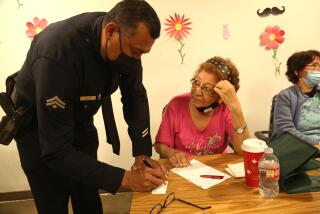Study Finds Customers Pay in 30% of Cases, Banks in 36% : ’83 Automated Teller Loss: $100 Million
- Share via
WASHINGTON — Banks lost between $70 million and $100 million in 1983 and their customers were bilked out of millions more through fraudulent use of automated tellers, according to a report made public Sunday by the Justice Department. But it said future losses can be reduced if customers will take steps to protect the secrecy of the codes that give them access to their accounts.
The study, which examined 2,707 complaints by holders of automatic teller cards in 1983, found that two-thirds of the problems grew out of withdrawals and 45% involved unauthorized use of lost or stolen bank cards, overdrafts or improper deposits.
Noting that lost or stolen cards figured in one-third of the challenged withdrawals, the report said customers victimized in 72% of these cases admitted that they had kept their code numbers, which give anyone using their cards access to their funds, near the places in their wallets or purses where they kept their bank cards.
Memorization Urged
“This finding suggests that a significant amount of ATM (automatic teller machine) fraud might be eliminated if card holders memorized or were more careful about concealing their numbers,” said Steven R. Schlesinger, director of the department’s Bureau of Justice Statistics.
The study found that one-fourth of the bank cards that were reported missing had been stolen from dwellings, 20% were lost in stores, 18% from cars, 8% on the street and 7% in schools.
The report was the first on automated teller fraud. It used data supplied by 16 commercial banks, all but one of which have deposits in excess of $1 billion. The number of complaints represented a minuscule fraction (0.0001%) of the 2.7 billion transactions involving $262 billion that passed nationwide in 1983 through 43,800 automatic teller installations.
Banks took the full loss in 445, or 36.7%, of the apparently fraudulent transactions, the report said, but customers suffered the loss in 370 cases, or 30.3% of the fraud-tainted incidents. It said losses were shared in 200 cases, or 16.6% of the total. Full data on losses were unavailable in the remaining cases.
Banks Cite ‘Problems’
The report, entitled “Electronic Fund Transfer Fraud,” also found that 12 of the 16 banks questioned for the survey reported “problems” with 139 of their electronic transfers of large sums of money in transactions with other banks.
The report said the transactions covered by the survey averaged about $800,000 each, and said 56% of the incidents resulted in a loss to the bank involved. But it gave no further specifics, noting that the banks had been promised “total anonymity.” It said that in 1980, the last year for which national data was available, U.S. banks completed about 60 million “wire transfers” involving about $117 trillion.
The report said the substantial losses from misused automatic tellers are still less than losses from fraudulent use of consumer credit cards.
Some credit card issuers are reluctant to make loss figures public, but the report said in a footnote that a private study estimated total credit card losses in 1984 at $560 million. It said losses through fraud in 1983 were estimated at $113 million by the VISA system and $65 million by MasterCard.
More to Read
Sign up for Essential California
The most important California stories and recommendations in your inbox every morning.
You may occasionally receive promotional content from the Los Angeles Times.










